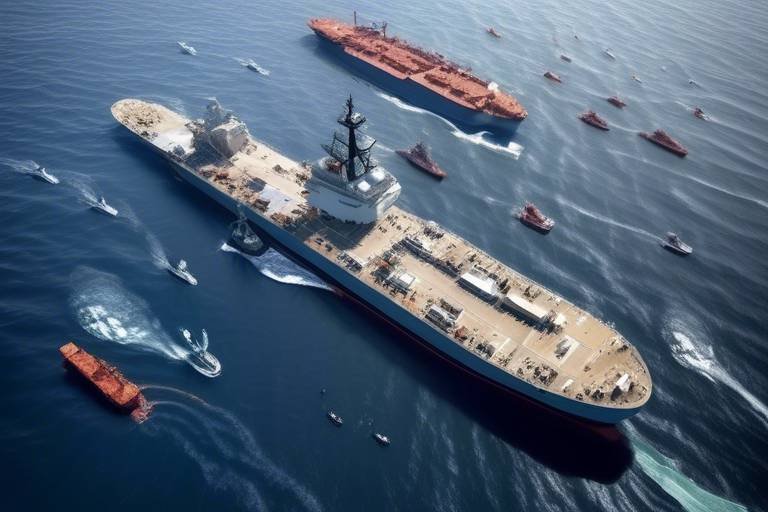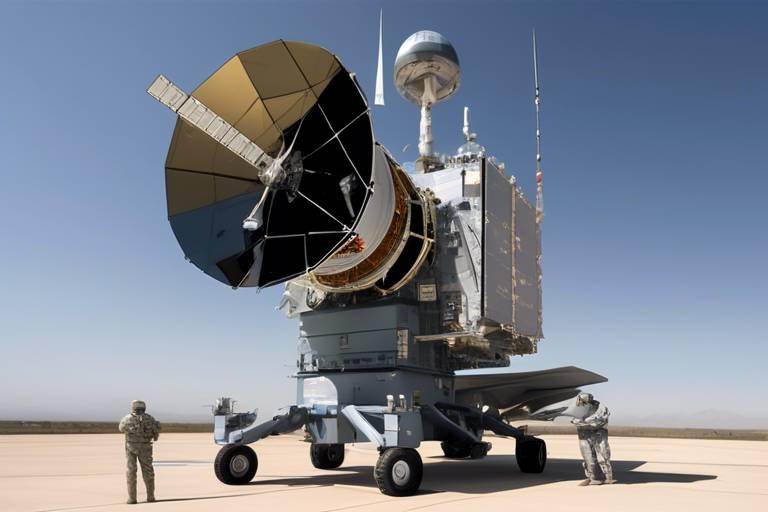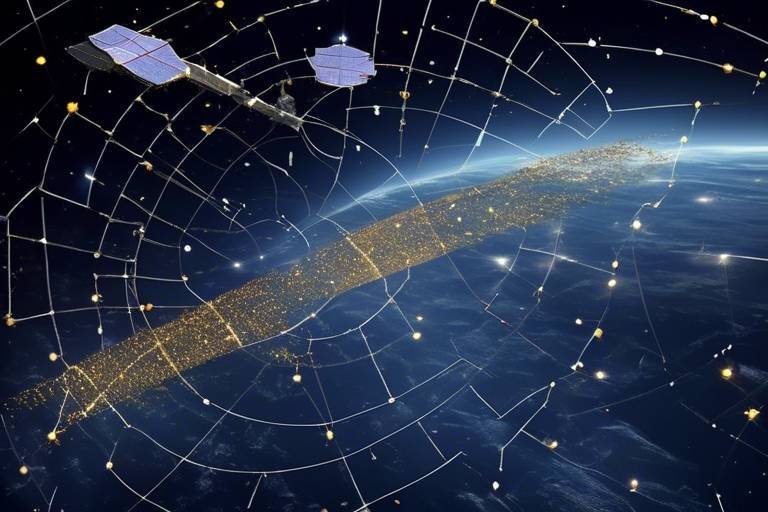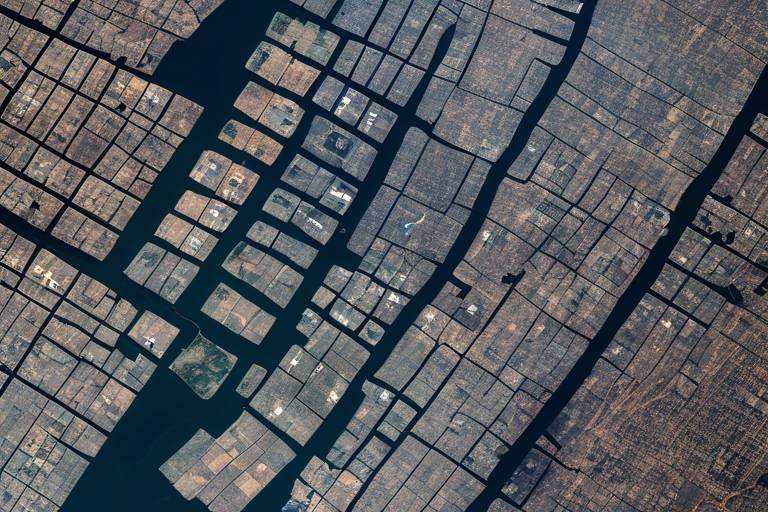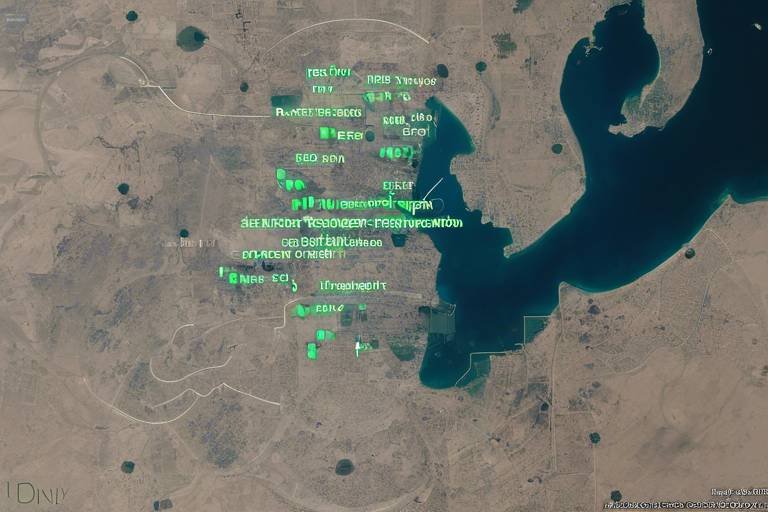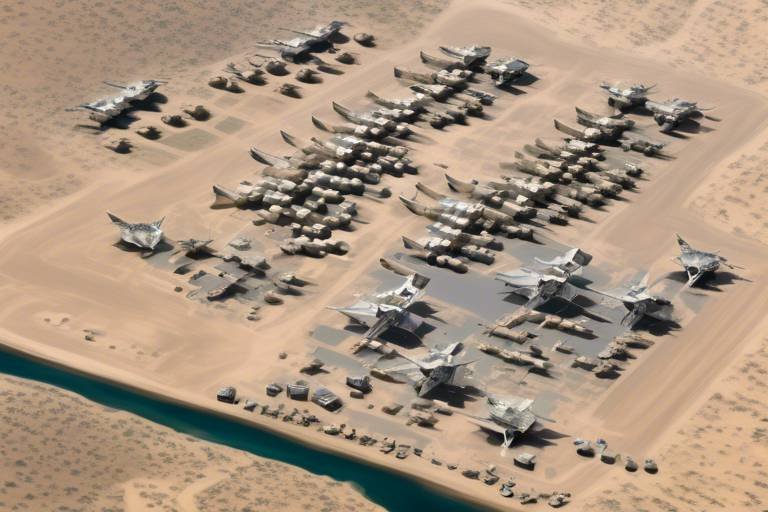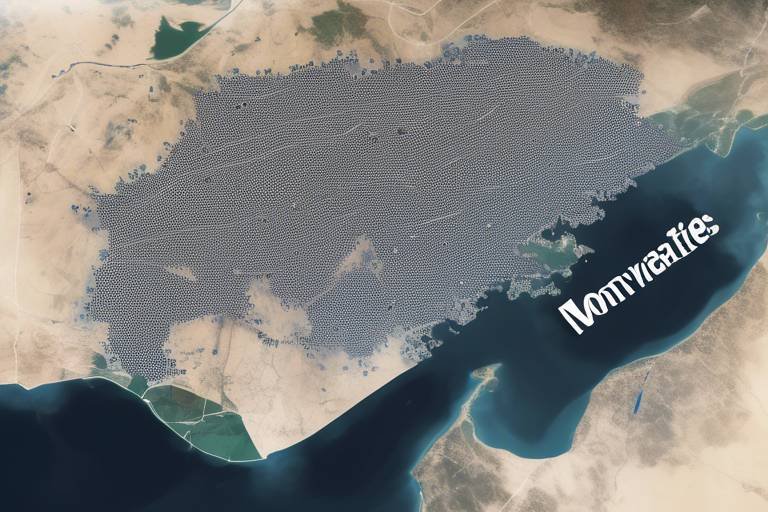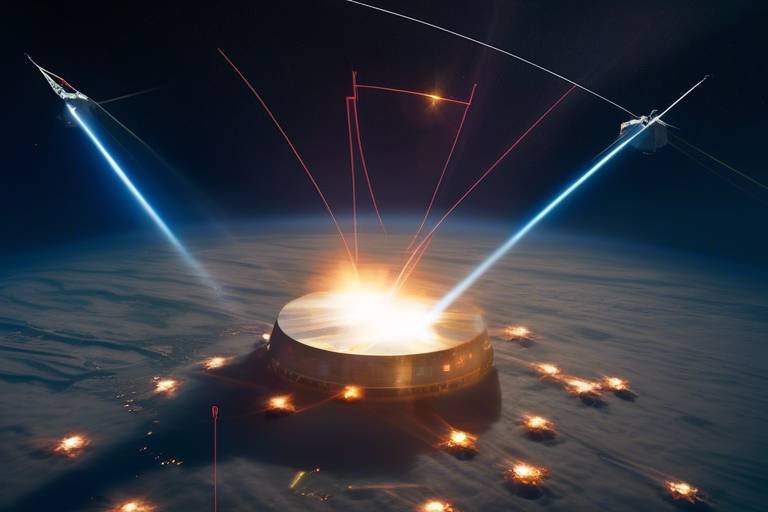Understanding the Use of Satellites for Force Projection
In today's rapidly evolving military landscape, the importance of satellites in enhancing force projection cannot be overstated. These celestial sentinels orbiting our planet play a pivotal role in modern warfare, acting as the backbone of strategic planning, intelligence gathering, and real-time communications. Imagine a chess game where every move is monitored, analyzed, and countered with precision—that's how satellites transform military operations. They provide commanders with the tools needed to foresee potential threats and respond dynamically to an ever-changing battlefield.
Satellites are not just passive observers; they are active participants in military strategy. By delivering real-time data and intelligence, they empower military leaders to make informed decisions, allowing for a more flexible and adaptive approach to combat. For instance, during a conflict, the ability to receive immediate updates on enemy movements can mean the difference between success and failure. This capability enhances situational awareness, enabling forces to project power effectively across vast distances, regardless of geographical barriers.
Moreover, the integration of satellite technology into military operations has revolutionized the way nations conduct surveillance and intelligence operations. Gone are the days of relying solely on ground-based reconnaissance; now, we have an array of sophisticated satellites that can monitor enemy activities from above. This shift not only increases the effectiveness of tactical planning but also significantly contributes to national security. The data collected by these satellites can be analyzed to predict enemy actions, assess potential threats, and develop strategies that leverage the element of surprise.
In essence, satellites have become indispensable tools for military force projection. They enhance the ability of armed forces to operate seamlessly across different terrains and environments, providing crucial support in both peacetime and combat situations. As we delve deeper into the various roles that satellites play in military strategy, it becomes clear that their impact is profound and far-reaching. From intelligence gathering to real-time communications, these technological marvels are reshaping the future of warfare.
Satellites are crucial in shaping military strategies by providing real-time data and intelligence, enabling commanders to make informed decisions and adapt to dynamic battlefield conditions effectively.
The use of satellites for intelligence gathering has revolutionized surveillance operations, allowing for comprehensive monitoring of enemy movements and activities, which is vital for national security and tactical planning.
Different types of surveillance satellites serve distinct purposes, including optical, radar, and signals intelligence satellites, each contributing unique capabilities to enhance situational awareness and operational effectiveness.
Optical satellites capture high-resolution images of the Earth's surface, providing critical visual information that aids in reconnaissance and assessment of enemy infrastructure and troop deployments.
Radar satellites utilize synthetic aperture radar technology to penetrate cloud cover and darkness, offering reliable surveillance capabilities regardless of weather conditions, which is essential for continuous monitoring.
SIGINT satellites intercept and analyze electronic communications, providing valuable insights into enemy intentions and capabilities, thereby enhancing strategic planning and operational readiness.
Satellites facilitate secure and rapid communication across military units, ensuring that commanders and troops remain connected regardless of geographical constraints, which is vital for coordinated operations.
Various satellite communication systems, including military and commercial satellites, provide essential bandwidth and connectivity for voice, data, and video transmissions in remote and hostile environments.
Despite their advantages, satellite communication faces challenges such as signal latency, jamming, and potential vulnerabilities to cyber threats, necessitating robust security measures and alternative communication methods.
Emerging technologies in satellite systems, including miniaturization and enhanced capabilities, promise to further revolutionize military operations, making them more efficient and adaptable to the evolving landscape of warfare.
- How do satellites improve military communication? Satellites enhance communication by providing secure and instantaneous connections between military units, regardless of their location.
- What types of satellites are used for surveillance? Various satellites are employed for surveillance, including optical, radar, and signals intelligence satellites, each serving unique purposes.
- What are the challenges faced by satellite communications? Challenges include signal latency, jamming, and susceptibility to cyber threats, which require advanced security measures.
- How will future satellite technology impact military operations? Future advancements in satellite technology will lead to more efficient and adaptable military operations, enhancing overall effectiveness.
Role of Satellites in Military Strategy
In today's fast-paced and ever-evolving battlefield, satellites play a pivotal role in shaping military strategies. Imagine being a general trying to make critical decisions without real-time data—it's like trying to navigate a stormy sea without a compass! Satellites provide the essential real-time data and intelligence that commanders need to make informed choices, adapt strategies, and respond to dynamic battlefield conditions effectively. This capability enhances situational awareness, allowing military leaders to visualize the operational landscape as if they were right there in the thick of it.
One of the most significant advantages of satellite technology is its ability to offer a comprehensive view of the battlefield. With satellites orbiting high above, military strategists can monitor troop movements, assess enemy positions, and even track logistical routes. This wealth of information enables commanders to foresee potential threats and opportunities, making it easier to devise tactical maneuvers that can turn the tide of battle. For instance, during an operation, if a commander notices an unexpected buildup of enemy forces in a particular area, they can quickly adjust their plans to either engage or avoid conflict, ensuring their troops are always one step ahead.
Furthermore, satellites facilitate communication between different military units, ensuring that everyone is on the same page. Think of it as a giant game of chess, where each piece must be in constant communication with others to ensure a successful strategy. The ability to relay information swiftly and securely across vast distances means that decisions can be made rapidly, which is crucial in high-stakes situations where every second counts. The integration of satellite data into military operations not only enhances operational efficiency but also minimizes the risks associated with miscommunication and delays.
However, the role of satellites in military strategy is not without challenges. As technology advances, so do the tactics employed by adversaries. Counter-satellite measures such as jamming and cyber-attacks pose significant threats to satellite operations, potentially compromising the very advantages they provide. Thus, military strategists must continually innovate and adapt their satellite capabilities to maintain an edge over potential threats. This ongoing evolution is akin to a cat-and-mouse game, where staying ahead requires constant vigilance and adaptation.
In summary, the role of satellites in military strategy is indispensable. They provide essential data and communication support that empower military leaders to make informed decisions and execute effective operations. As satellite technology continues to evolve, its integration into military strategy will only become more profound, shaping the future of warfare in ways we are just beginning to understand.
Intelligence Gathering and Surveillance
The use of satellites for intelligence gathering has truly revolutionized surveillance operations in modern military strategy. Imagine having the ability to monitor enemy movements and activities from thousands of miles away, all while remaining undetected. This capability is not just a game-changer; it's a necessity for ensuring national security and effective tactical planning. With the right satellite technology, military commanders can access real-time data that informs their decisions and helps them anticipate enemy actions. This level of insight is crucial in today's fast-paced and unpredictable battlefield environments.
One of the most significant advantages of satellite intelligence is the ability to conduct comprehensive monitoring over vast areas. Unlike traditional methods, which may involve ground reconnaissance or aerial surveillance, satellites provide a bird's-eye view that is both extensive and precise. This capability allows for the identification of not only troop movements but also the logistical capabilities of an adversary, such as the location of supply depots or command centers. The strategic implications of this information can be profound, enabling military planners to devise counter-strategies that can neutralize threats before they escalate.
To fully appreciate the impact of satellite technology on intelligence gathering, it’s essential to understand the different types of surveillance satellites that are in operation today. Each type serves distinct purposes, contributing unique capabilities to enhance situational awareness. Here’s a brief overview of the primary categories:
| Type of Satellite | Function | Key Benefits |
|---|---|---|
| Optical Satellites | Capture high-resolution images | Excellent for reconnaissance |
| Radar Satellites | Utilize radar technology | Effective in all weather conditions |
| Signals Intelligence (SIGINT) Satellites | Intercept electronic communications | Provide insights into enemy intentions |
Optical satellites are particularly fascinating. They capture high-resolution images of the Earth's surface, allowing military analysts to assess enemy infrastructure and troop deployments with remarkable clarity. This visual data is invaluable for planning operations and can sometimes be the difference between success and failure in a mission. Think of it as having a detailed map in a game of chess; the more you know about your opponent's position, the better your chances of winning.
On the other hand, radar satellites employ synthetic aperture radar technology to penetrate cloud cover and darkness. This means they can provide reliable surveillance capabilities regardless of weather conditions. Imagine trying to play a sport in the rain; if you can see clearly, you can play effectively. Radar satellites ensure that military operations can continue smoothly, even when the skies are not cooperating.
Lastly, we have Signals Intelligence (SIGINT) satellites, which intercept and analyze electronic communications. These satellites offer a treasure trove of information, providing insights into enemy intentions and capabilities. It’s like having a spy in the enemy camp, one who can relay crucial information back to commanders. This capability enhances strategic planning and operational readiness, allowing military forces to stay one step ahead of their adversaries.
In conclusion, the integration of satellite technology into military intelligence gathering and surveillance has transformed how nations approach warfare. With the ability to gather real-time data, analyze enemy movements, and communicate securely, military forces are better equipped to respond to threats and execute their missions effectively. The future of military operations will undoubtedly rely heavily on these remarkable technologies, making them indispensable in the quest for national security.
- What are the primary types of surveillance satellites? The main types include optical satellites, radar satellites, and signals intelligence (SIGINT) satellites, each serving unique functions.
- How do satellites enhance military strategy? They provide real-time data and intelligence, allowing commanders to make informed decisions and adapt to battlefield conditions.
- What challenges do satellite communications face? Challenges include signal latency, jamming, and vulnerabilities to cyber threats.
Types of Surveillance Satellites
When we delve into the realm of surveillance satellites, it's essential to recognize that not all satellites are created equal. Each type serves a unique purpose, tailored to meet specific military needs. Understanding these distinctions can illuminate how they contribute to the broader scope of military intelligence and operational success. At the forefront, we have optical satellites, which are renowned for their ability to capture stunningly detailed images of the Earth's surface. These high-resolution images play a pivotal role in reconnaissance missions, allowing military officials to assess enemy infrastructure, troop deployments, and even changes in terrain that could impact strategic planning.
On the other hand, we have radar satellites, which are equipped with synthetic aperture radar technology. Unlike their optical counterparts, radar satellites can see through clouds and darkness, providing consistent surveillance capabilities regardless of the weather. This feature is crucial for continuous monitoring of areas that might be obscured from visual observation, ensuring that military forces maintain an edge in situational awareness. Picture a watchful eye that never blinks; that's the essence of radar satellites in action.
Lastly, we can't overlook the significance of signals intelligence (SIGINT) satellites. These technological marvels intercept and analyze electronic communications, offering invaluable insights into enemy intentions and capabilities. By tapping into the communication channels of adversaries, SIGINT satellites enhance strategic planning and operational readiness, making them indispensable in modern warfare. To summarize, the three primary types of surveillance satellites—optical, radar, and SIGINT—each contribute uniquely to military operations, providing a comprehensive toolkit for intelligence gathering and strategic planning.
| Type of Satellite | Primary Function | Key Features |
|---|---|---|
| Optical Satellites | High-resolution imaging | Visual reconnaissance, detailed terrain assessment |
| Radar Satellites | All-weather surveillance | Penetrates clouds and darkness, continuous monitoring |
| SIGINT Satellites | Electronic communication interception | Analyzes enemy communications, enhances strategic planning |
Optical Satellites
Optical satellites are a fascinating component of modern military operations, serving as the eyes in the sky that provide crucial visual intelligence. Imagine having a bird's-eye view of the battlefield, capturing high-resolution images that can reveal not just the locations of enemy troops but also the intricate details of their infrastructure. This capability is vital for reconnaissance missions, allowing military commanders to assess potential threats and make informed decisions quickly. The images captured by these satellites can be processed and analyzed to generate actionable intelligence, which can significantly alter the course of an operation.
One of the standout features of optical satellites is their ability to produce stunningly detailed imagery. These satellites operate in various spectrums, capturing data in visible light, infrared, and even multispectral ranges. This means they can detect not just what is happening on the ground but also changes in the environment that might indicate military activity, such as the movement of vehicles or the construction of new facilities. For instance, if a country is secretly building a military base, optical satellites can spot the construction materials and equipment, providing a clear indication of the enemy's intentions.
However, the effectiveness of optical satellites isn't without its challenges. Their functionality can be significantly hampered by weather conditions such as cloud cover or heavy rain. Unlike radar satellites, which can see through clouds, optical satellites require clear skies to capture high-quality images. This limitation means that military planners must often rely on a combination of different types of satellites to ensure comprehensive surveillance. For example, while an optical satellite might be capturing images during a clear day, radar satellites can continue to monitor activities during adverse weather, ensuring that no critical developments go unnoticed.
In addition to their surveillance capabilities, optical satellites also play a crucial role in supporting humanitarian missions and disaster relief operations. After a natural disaster, these satellites can provide vital information about affected areas, helping relief organizations assess damage and plan their response effectively. The ability to visualize the extent of destruction can aid in resource allocation, ensuring that help reaches those who need it most.
To summarize, optical satellites are indispensable tools in modern military strategy, offering high-resolution imagery that enhances situational awareness and operational effectiveness. As technology continues to advance, we can expect these satellites to become even more sophisticated, providing clearer images and faster data transmission. The integration of optical satellites into military operations not only improves tactical planning but also enhances national security by allowing for proactive measures against potential threats.
Radar Satellites
Radar satellites are a game-changer in the realm of surveillance and reconnaissance. Unlike their optical counterparts, which rely on visible light, radar satellites utilize synthetic aperture radar (SAR) technology to gather data. This means they can see through clouds, fog, and even darkness, providing a significant advantage in various operational environments. Imagine being able to monitor enemy movements regardless of the weather conditions or time of day—this capability is essential for maintaining an edge in military operations.
One of the primary functions of radar satellites is their ability to conduct all-weather surveillance. They emit radar waves that bounce off objects on the Earth's surface, returning detailed information about their location and movement. This information is invaluable for military strategists who need to assess threats in real-time. For instance, during a conflict, radar satellites can track troop movements, monitor supply routes, and even detect changes in enemy infrastructure.
Moreover, radar satellites can be equipped with different modes of operation, allowing them to perform various tasks. Some of these modes include:
- Spotlight Mode: Provides high-resolution images of a specific area.
- Stripmap Mode: Captures wide swathes of land, useful for monitoring large areas.
- Interferometric Mode: Measures ground deformation, which is crucial for assessing damage after an earthquake or explosion.
The ability to gather such diverse information makes radar satellites indispensable for military operations. They not only enhance situational awareness but also play a critical role in strategic planning. With the data collected from these satellites, commanders can make informed decisions, ensuring that their forces are deployed effectively and efficiently.
However, it’s important to note that while radar satellites offer incredible capabilities, they are not without their challenges. The data they collect can be complex and requires advanced processing techniques to interpret accurately. Additionally, adversaries may attempt to employ countermeasures to disrupt radar signals, making it essential for military forces to continuously innovate and adapt their technologies.
In summary, radar satellites represent a technological leap forward in military surveillance. Their ability to operate in adverse weather conditions and provide real-time data is crucial for modern warfare. As military operations become increasingly reliant on technology, the role of radar satellites will undoubtedly continue to expand, shaping the future of military strategy and operations.
- What are radar satellites used for?
Radar satellites are primarily used for surveillance, reconnaissance, and monitoring of enemy movements and infrastructure. - How do radar satellites work?
They emit radar waves that bounce off objects on the Earth's surface, returning data that can be analyzed for various purposes. - Can radar satellites operate in bad weather?
Yes, radar satellites can see through clouds and fog, making them effective for all-weather surveillance. - What is synthetic aperture radar?
Synthetic aperture radar (SAR) is a technology that allows radar satellites to create high-resolution images of the Earth's surface.
Signals Intelligence (SIGINT) Satellites
Signals Intelligence (SIGINT) satellites play a pivotal role in modern military operations by intercepting and analyzing electronic communications. Imagine having a powerful ear in the sky that can listen to the chatter of enemy forces, deciphering their intentions and capabilities in real-time. This capability is not just a luxury; it’s a necessity for maintaining national security and ensuring tactical superiority on the battlefield.
These satellites are equipped with advanced sensors that can capture a wide range of signals, from radio transmissions to satellite communications. By analyzing these signals, military analysts can gain invaluable insights into enemy movements, strategies, and even their morale. For instance, if a SIGINT satellite intercepts communications indicating an enemy’s troop mobilization, commanders can adjust their strategies accordingly, potentially thwarting a surprise attack.
One of the remarkable features of SIGINT satellites is their ability to operate in a variety of environments. Whether it’s a bustling urban area or a remote desert, these satellites can provide critical data that enhances situational awareness. Moreover, they can function in conjunction with other intelligence-gathering methods, such as optical and radar satellites, creating a comprehensive picture of the operational landscape.
However, the effectiveness of SIGINT satellites is not without challenges. They must navigate the complexities of electronic warfare, where adversaries may employ countermeasures to jam or spoof signals. This cat-and-mouse game requires continuous advancements in technology and tactics to ensure that SIGINT capabilities remain robust and reliable. It’s like a chess match played on a global scale, where each move can have significant consequences.
In summary, SIGINT satellites are essential tools in the arsenal of modern military forces. They provide critical intelligence that informs strategic planning and operational readiness. As technology continues to evolve, the capabilities of these satellites will only expand, enabling military forces to maintain a strategic edge over their adversaries.
- What is the primary function of SIGINT satellites?
The primary function of SIGINT satellites is to intercept and analyze electronic communications, providing insights into enemy operations and intentions.
- How do SIGINT satellites contribute to national security?
By gathering intelligence on enemy activities, SIGINT satellites help military leaders make informed decisions, enhancing national security and tactical effectiveness.
- What challenges do SIGINT satellites face?
Challenges include electronic warfare tactics by adversaries, such as jamming and spoofing, which necessitate ongoing technological advancements.
Real-Time Communication Support
In the fast-paced world of military operations, real-time communication is not just a luxury; it's a necessity. Imagine being on the battlefield, where every second counts, and decisions must be made swiftly. This is where satellites come into play, acting as the backbone of communication for military units scattered across vast geographical areas. With the ability to transmit voice, data, and video, satellites ensure that commanders and troops can maintain a constant flow of information, crucial for executing coordinated operations.
One of the standout features of satellite communication is its ability to operate in remote and hostile environments. Unlike traditional communication systems that may falter due to terrain or infrastructure limitations, satellite systems can reach even the most isolated units. This connectivity is vital, especially when troops are deployed in areas lacking reliable ground-based communication networks. For instance, during a mission in a mountainous region, where radio signals may struggle to penetrate the rugged landscape, satellite communication provides the necessary link to command centers, ensuring that soldiers receive timely updates and instructions.
Moreover, the integration of military and commercial satellites has significantly expanded communication capabilities. Military satellites are designed with robust security features to protect sensitive information, while commercial satellites offer additional bandwidth that can be leveraged during high-demand situations. This hybrid approach not only enhances communication efficiency but also ensures that military forces can adapt to varying operational needs. The table below illustrates the different types of satellites used for communication:
| Type of Satellite | Purpose | Key Features |
|---|---|---|
| Military Satellites | Secure military communications | High security, specialized for defense operations |
| Commercial Satellites | General communication support | Wider coverage, cost-effective |
| Hybrid Systems | Enhanced bandwidth and flexibility | Combines strengths of both military and commercial |
However, it's important to note that satellite communication is not without its challenges. Issues such as signal latency can hinder the immediacy of communication, making it difficult for commanders to receive real-time updates. Additionally, the risk of jamming and cyber threats poses a significant concern, as adversaries may attempt to disrupt communication channels. To combat these vulnerabilities, military forces are investing in advanced encryption technologies and alternative communication methods to ensure that operations remain seamless and secure.
In conclusion, the role of satellites in providing real-time communication support cannot be overstated. They are essential for maintaining connectivity in the most challenging environments, enabling military units to operate effectively and efficiently. As technology continues to evolve, we can expect even greater advancements in satellite communication, further enhancing the capabilities of modern military operations.
- What is the primary role of satellites in military communication? Satellites provide secure and reliable communication links between commanders and troops, ensuring real-time information flow.
- How do satellites enhance operational efficiency? By enabling communication in remote areas and during adverse conditions, satellites allow for coordinated military operations.
- What are the challenges faced by satellite communication? Challenges include signal latency, jamming, and vulnerabilities to cyber threats, which require robust security measures.
- What types of satellites are used for military communication? Military and commercial satellites are commonly used, each serving distinct purposes to enhance communication capabilities.
Satellite Communication Systems
In the realm of modern warfare, have become the backbone of military operations, ensuring that every unit remains interconnected regardless of the challenges posed by geography or hostile environments. Imagine being in a remote location, surrounded by rugged terrain or enemy lines, yet being able to communicate seamlessly with your command center. That’s the power of satellite communication! These systems provide essential bandwidth and connectivity for voice, data, and video transmissions, making them indispensable in today’s fast-paced military engagements.
At the heart of these systems are various types of satellites, each designed to fulfill specific communication needs. Some of the key types include:
- Military Satellites: Specifically designed for defense purposes, these satellites offer secure communication channels that are less susceptible to interception.
- Commercial Satellites: While primarily used for civilian purposes, many commercial satellites also support military operations, offering additional bandwidth and redundancy.
- Geostationary Satellites: Positioned in a fixed orbit, these satellites provide continuous coverage over specific areas, making them ideal for stable communication links.
- Low Earth Orbit (LEO) Satellites: These satellites orbit closer to the Earth, reducing latency and improving the speed of communication, which is crucial in combat situations.
However, the effectiveness of satellite communication systems is not without challenges. Issues such as signal latency can hinder real-time communications, especially in fast-moving tactical situations. Additionally, the threat of jamming and cyber-attacks poses significant risks, necessitating the development of robust security measures. Military strategists are continually exploring alternative communication methods, such as mesh networks and ground-based relay systems, to mitigate these vulnerabilities.
As technology advances, we can expect to see further enhancements in satellite communication systems. Innovations like miniaturization of satellite technology and improved encryption methods will pave the way for more secure and efficient military operations. The future of warfare is undoubtedly intertwined with these advancements, making it imperative for military forces to adapt and evolve in response to emerging threats and challenges.
Challenges in Satellite Communication
While satellites have revolutionized military operations, they are not without their challenges. One of the most significant issues is signal latency. This delay can hinder real-time decision-making, especially in fast-paced combat situations where every second counts. Imagine trying to coordinate a complex maneuver with your team, only to find that the information you receive is outdated by the time it arrives. This is a critical concern that military strategists must address to maintain operational effectiveness.
Another challenge is jamming. Adversaries can use various techniques to disrupt satellite signals, rendering communication ineffective. This is particularly problematic during crucial missions where reliable communication is paramount. For instance, if a satellite communication link is jammed, units on the ground may lose contact with their command center, leading to confusion and potential failure of the operation.
Moreover, satellites are also vulnerable to cyber threats. As technology advances, so do the tactics employed by adversaries. Cyber attacks can target satellite systems, compromising their functionality and potentially exposing sensitive information. The need for robust security measures cannot be overstated, as a breach could have catastrophic consequences for military operations.
In addition to these challenges, environmental factors can also impact satellite communication. For example, adverse weather conditions such as heavy rain or storms can interfere with signal transmission, leading to disruptions in communication. The reliability of satellite systems must be ensured, even in the most challenging environments, to maintain operational readiness.
To combat these challenges, military organizations are investing in alternative communication methods. This includes the development of ground-based systems and mesh networks that can operate independently of satellite links. By diversifying communication strategies, military forces can enhance their resilience against potential disruptions and ensure that they remain connected, no matter the circumstances.
In summary, while satellites play a crucial role in modern military communication, they face several challenges that must be addressed. By understanding these issues and developing innovative solutions, military forces can continue to leverage satellite technology effectively, ensuring that they maintain a strategic advantage in various operational environments.
- What is signal latency in satellite communication?
Signal latency refers to the delay in transmitting data between a satellite and its ground station, which can affect real-time decision-making. - How can jamming impact military operations?
Jamming can disrupt satellite signals, leading to loss of communication between military units and command centers, which is critical during missions. - What are the cybersecurity risks associated with satellites?
Satellites are vulnerable to cyber attacks that can compromise their functionality and expose sensitive military information. - How do environmental factors affect satellite communication?
Adverse weather conditions can interfere with signal transmission, leading to disruptions in communication. - What alternative communication methods are being developed?
Military organizations are exploring ground-based systems and mesh networks to provide reliable communication independent of satellite links.
Future Trends in Satellite Technology
As we look to the horizon of military operations, the future of satellite technology is poised to bring about remarkable changes that will redefine how we project force and maintain security. The rapid advancement in technology is not just a trend; it’s a revolution that promises to enhance efficiency, adaptability, and overall effectiveness of military missions. One of the most exciting developments is the miniaturization of satellites. This trend allows for the deployment of smaller, lighter satellites that can be launched in swarms, creating a network of interconnected devices that provide extensive coverage and real-time data.
Moreover, advancements in artificial intelligence (AI) and machine learning are being integrated into satellite operations. Imagine satellites that can autonomously analyze data and identify potential threats without waiting for human intervention. This capability not only speeds up the decision-making process but also enhances situational awareness on the battlefield. With AI, these satellites can filter through vast amounts of data, pinpointing what’s most relevant, and alerting commanders to significant developments.
Another significant trend is the increasing use of low Earth orbit (LEO) satellites. Unlike traditional satellites that operate in geostationary orbits, LEO satellites are positioned closer to the Earth, resulting in lower latency and faster data transmission. This is crucial for real-time communication and surveillance, especially in fast-paced military operations. The combination of LEO satellites with advanced ground stations can create a robust communication network that is less susceptible to jamming and other electronic warfare tactics.
Additionally, the concept of constellations is gaining traction. By deploying multiple satellites that work in tandem, military forces can achieve comprehensive global coverage. For instance, a constellation of satellites can provide continuous monitoring of a specific area, ensuring that no movement goes unnoticed. This capability is particularly vital in today’s complex operational environments where threats can emerge unexpectedly.
However, with these advancements come challenges. As military reliance on satellite technology grows, so does the need for cybersecurity. Protecting satellite systems from hacking and electronic warfare is of utmost importance. Future trends will likely include the development of more secure communication protocols and encryption methods to safeguard sensitive military information.
In summary, the future of satellite technology in military operations is not just about enhancing existing capabilities; it's about transforming the very nature of how we conduct warfare. With innovations in miniaturization, AI, LEO satellites, and constellation deployment, the military landscape is set to evolve dramatically. As these technologies continue to develop, we can expect a new era of strategic advantage that will shape the future of defense and security.
- What are LEO satellites? LEO satellites are satellites that orbit the Earth at low altitudes, providing faster data transmission and lower latency compared to traditional geostationary satellites.
- How does AI enhance satellite capabilities? AI enables satellites to autonomously analyze data, identify threats, and filter through vast amounts of information, enhancing situational awareness and decision-making speed.
- What challenges do military satellites face? Military satellites face challenges like signal jamming, cyber threats, and the need for robust security measures to protect sensitive information.
- What is the significance of satellite constellations? Satellite constellations allow for comprehensive global coverage and continuous monitoring, essential for effective military operations in dynamic environments.
Frequently Asked Questions
-
How do satellites enhance military strategy?
Satellites play a pivotal role in military strategy by providing real-time data and intelligence. This information allows commanders to make informed decisions and adapt their tactics based on the ever-changing dynamics of the battlefield.
-
What types of surveillance satellites are used?
There are several types of surveillance satellites, including optical, radar, and signals intelligence (SIGINT) satellites. Each type serves a unique purpose, contributing to a comprehensive understanding of the operational environment and enhancing situational awareness.
-
What are optical satellites used for?
Optical satellites capture high-resolution images of the Earth's surface. These images are essential for reconnaissance missions and help assess enemy infrastructure and troop movements, providing critical visual intelligence.
-
How do radar satellites work?
Radar satellites utilize synthetic aperture radar technology to penetrate cloud cover and darkness. This capability ensures reliable surveillance regardless of weather conditions, allowing continuous monitoring of targets.
-
What is the role of SIGINT satellites?
SIGINT satellites intercept and analyze electronic communications, offering valuable insights into enemy intentions and capabilities. This information is crucial for strategic planning and maintaining operational readiness.
-
How do satellites support real-time communication in military operations?
Satellites facilitate secure and rapid communication across military units. They ensure that commanders and troops stay connected, which is vital for coordinated operations, especially in remote or hostile environments.
-
What challenges do satellite communications face?
Despite their advantages, satellite communications face challenges like signal latency, jamming, and vulnerabilities to cyber threats. These issues necessitate robust security measures and alternative communication methods to ensure reliability.
-
What are the future trends in satellite technology?
Emerging technologies such as miniaturization and enhanced capabilities are set to revolutionize military operations. These advancements will make operations more efficient and adaptable to the evolving landscape of warfare.



